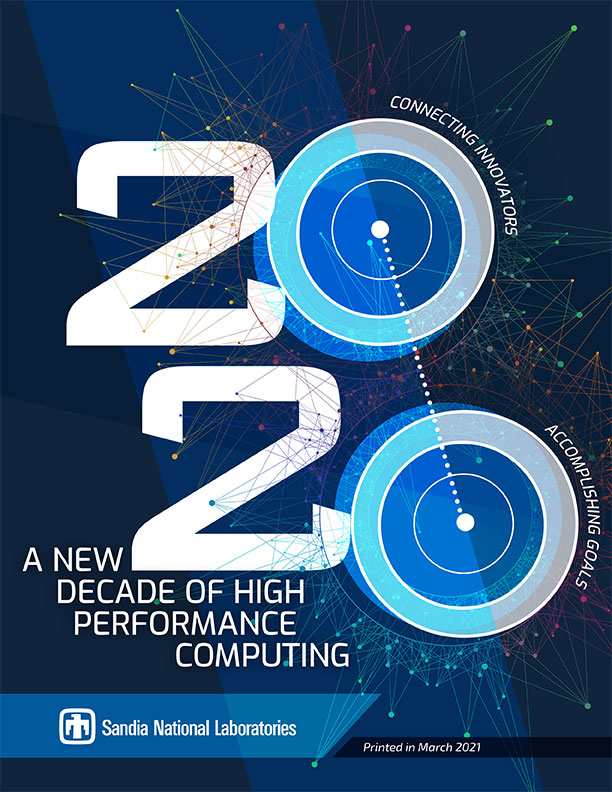Sandia’s High Performance Computing tackles the nation’s toughest challenges

Sandia National Laboratories is known around the world for its expertise and leadership in High Performance Computing (HPC), a capability critical to its national security missions. Our commitment to HPC includes advances in numerical algorithms, pioneering approaches to software development, and the deployment and application of the next-generation of supercomputing hardware. HPC is a foundation of Sandia’s Nuclear Deterrence (ND) stockpile stewardship mission and has far-ranging impact in areas including state-of-the-art energy systems, advanced materials, earth system modeling, and most recently our efforts to combat COVID-19.
Sandia is performing ND work on a level not seen in over 30 years. Our HPC capabilities support advanced physics simulation codes developed at Sandia that allow scientists and engineers to explore a variety of engineering options to identify low-cost, high-performing designs. These simulations are critical to understanding how systems behave in the most challenging environments and help ensure weapons will perform as intended.
At Sandia, the high-consequence nature of our national security work requires different, more exacting levels of simulation fidelity and confidence from those of other engineering endeavors. Design cycles and qualification turnaround times are steadily shortening, leading to an increased use of models as opposed to field tests and experiments. Consequently the demands on Sandia computer architectures and software has steadily increased and will enhance the sophistication and performance of HPC.
Harnessing the power of emerging, next-generation platforms requires new approaches to software engineering. A core software capability is the Kokkos library, which allows science and engineering application developers to achieve performance portability across multiple hardware architectures. Kokkos has been developed under Laboratory Directed Research and Development (LDRD) projects, the National Nuclear Security Administration’s (NNSA) Advanced Simulation and Computing (ASC) program, and the Department of Energy’s (DOE) Advanced Scientific Computing Research program including the Exascale Computing Project. Sandia recently developed two Kokkos-based exascale applications, EMPIRE and SPARC, that are the culmination of a multi-year effort supported by ASC. EMPIRE provides new simulation capabilities for a wider range of plasma regimes while SPARC is a hypersonic flow code that offers important new simulation capabilities for atmosphere re-entry environments.
Our high-fidelity modeling and simulation capabilities require computing platforms at the forefront of state-of-the-art. Great examples are the Advanced Architecture Testbed systems procured and managed by Sandia’s Computer Science Research and Operations centers that have kept the Labs at the leading edge of HPC technologies. Recent highlights include a new Fujitsu system with A64FX processors, acquisition of the large-scale neuromorphic Loihi system, and our upcoming Graphcore system targeting research and development in advanced machine learning algorithms. Sandia also uses its computing expertise to select emerging technologies as part of the Vanguard advanced technology prototype program. Following a successful demonstration of Arm-based processors on Astra, the first peta-scale class ARM platform, staff on Vanguard are selecting the next technology to evaluate in support of stockpile stewardship.
Importantly, Sandia scientists have recently harnessed the power of HPC to study and understand the spread of COVID-19. As the disease moved rapidly across the country, groundbreaking research using HPC gave decision-makers data to better understand how the virus might spread and mitigation options. That work continues as of this writing.
Our path is challenging but also exciting with emerging technologies and increased partnerships with colleagues, sponsors, and stakeholders. We are inspired and energized by these challenges and opportunities in the realm of HPC.
About this publication

This year you can watch innovation come to life using SNLSimMagic, an augmented reality application developed at Sandia National Laboratories.
Download the PDF version of the 2020 High Performance Computing Report and the SNLSimMagic app on your iOS device. Next, use your phone to scan images with an icon to watch content come to life.
Download the 2020 HPC Annual Report (PDF, 17.7 MB).